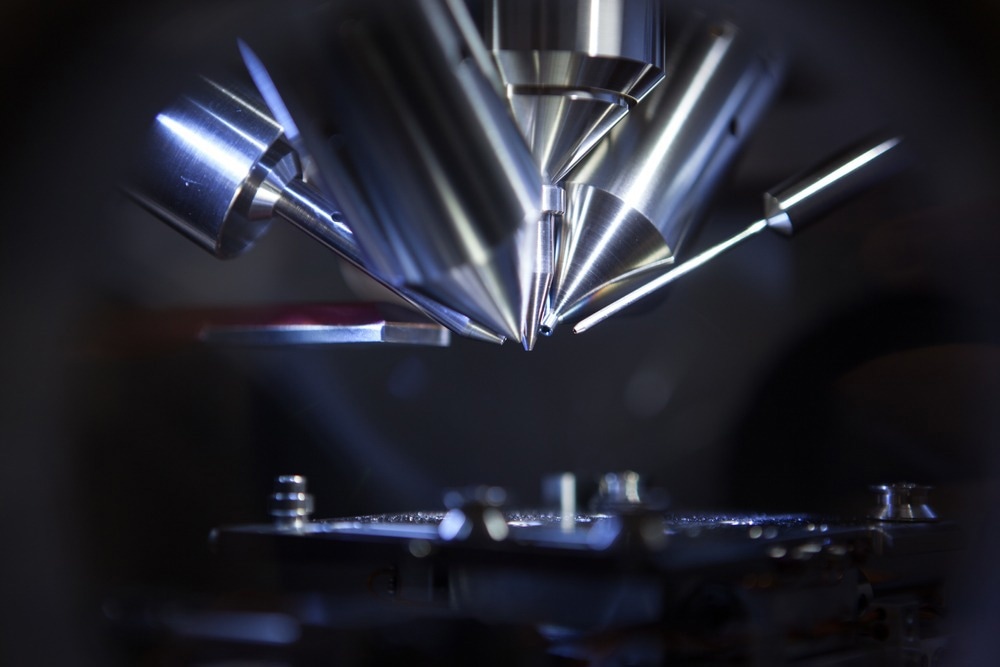Mass spectrometry is an analytical technique used for chemical identification. By ionizing and fragmenting the sample of interest and measuring the mass-to-charge ratios of the products formed, it is possible to see a ‘chemical fingerprint’ that can help work out a chemical structure. Mass spectrometry can also be used to identify unknown compounds.

Image Credit: Intothelight Photography/Shutterstock.com
Mass spectrometry is compatible with various sample types, from gaseous samples to large proteins. To deal with samples in complex environments, such as blood, urine or environmental material, mass spectrometry can also be combined with several complementary analytical techniques in hyphenation.1 This includes liquid phase chromatography or gas chromatography to enable sample separation and preparation before mass spectrum recording.
The wide availability of an extensive range of ionization sources and the compatibility of mass spectrometry with several sample types has made it a workhorse technique for many applications. Forensics, pharmaceutical development, chemical production, and medical diagnostics use mass spectrometry methods.2
Instrumentation and Method
A standard mass spectrometer consists of an ionization source, a flight region with electric and magnetic fields, and a detector. At the inlet, the sample is vaporized and then ionized. Sometimes ionization is performed by bombarding the sample with electrons in an electron impact process. However, other ionization methods, such as proton transfer or electrospray ionization, are considered ‘soft’ ionization techniques.3
A hard ionization technique such as electron impact ionizes the intact parent molecule and produces a high degree of fragmentation.
Some molecules, particularly larger molecular systems with many weak bonds, will undergo extensive fragmentation so that the parent molecule can no longer be detected. Softer ionization methods induce less fragmentation and are often better for ‘fragile’ biological species.
The ionization process does not necessarily just create a singly charged species. As mass spectrometers measure the mass-to-charge ratio of a species rather than just the mass, sometimes it is desirable to multiply the analyte charge. Using multiple charges is particularly common for very heavy species, such as large biomolecules, where the large mass makes it difficult to detect the single-charged species.
Some more sophisticated mass spectrometry instruments will have additional components, such as ion traps, to enhance the number of charged species available for detection.
While mass spectrometry is reasonably sensitive, some species do not produce enough ions in a single ionization event to be detected.4 Therefore, accumulating ions until sufficient densities have been achieved can be advantageous.
Once the charged species have been created, the ions fly through sectors with an electric or magnetic field. The electric fields are used to accelerate all the ions until they have the same kinetic energy, and the magnetic fields, often accompanied by a curved section in the instrument, are used to deflect the path of the charged particles where the radius of curvature of their flight is dependent on their mass-to-charge ratio.
Typical detectors in mass spectrometry instruments include electron multipliers, photomultipliers with imaging plates, or array detectors. The latter can even perform position-sensitive measurements.
Most spectrometers record the overall flight time of the ions and then use a known calibration of the flight times to convert this to a spectrum in mass-to-charge ratio.
Identifying Chemicals with Mass Spectrometry
Chemical identification with mass spectrometry uses the mass of the parent ion, if it can be detected. Many mass spectrometers also have highly accurate mass-to-charge detection. The greater the mass accuracy and resolution, the easier it is to identify a sample's elemental composition and perform speciation analysis for the presence of particular functional groups.
For example, chemical functional groups such as aldehydes and sulfides only differ by 0.035 Da. A mass spectrometry instrument capable of resolving mass differences on this order of magnitude would provide a unique identifier for the particular chemical species.
Another way to improve confidence in a chemical assignment or gain structural insights and elemental composition of a sample is to use the fragmentation patterns as additional information.
The fragmentation pattern and the relative abundance of particular fragment ions reflect the relative strength of the chemical bonds in the molecule. It is possible to work out where certain functional groups are in the overall chemical structure and something about the nature and strength of the local bonding environment.
The species information that can be provided by mass spectrometry means it is now being used as a tool in proteomics5 and for identifying complex chemical mixtures where there may be mass spectra from several different compounds overlapping. This is a common occurrence in forensic samples in particular.
References and Further Reading
- Maurer, H. H. (2006) Hyphenated mass spectrometric techniques – indispensable tools in clinical and forensic toxicology and in doping control. Journal of Mass Spectrometry, 41, 1399–1413. https://doi.org/10.1002/jms.1112
- Traldi, P., Magno, F., Lavagnini, I., & Seraglia, R. (2006). Quantitative applications of mass spectrometry. John Wiley & Sons. https://doi.org/10.1002/0470029021
- Kind, T., & Fiehn, O. (2010). Advances in structure elucidation of small molecules using mass spectrometry. Bioanal Rev, 2, 23–60. https://doi.org/10.1007/s12566-010-0015-9
- Eliuk, S., & Makarov, A. (2015). Evolution of Orbitrap Mass Spectrometry Instrumentation. Annual Reviews of Analytical Chemistry, 8, 61–80. https://doi.org/10.1146/annurev-anchem-071114-040325
- Cunsolo, V., & Foti, S. (2019). Mass spectrometry in proteomics. Mass Spectrometry: An Applied Approach, 261–272. https://doi.org/10.1002/9781119377368.ch8
Disclaimer: The views expressed here are those of the author expressed in their private capacity and do not necessarily represent the views of AZoM.com Limited T/A AZoNetwork the owner and operator of this website. This disclaimer forms part of the Terms and conditions of use of this website.